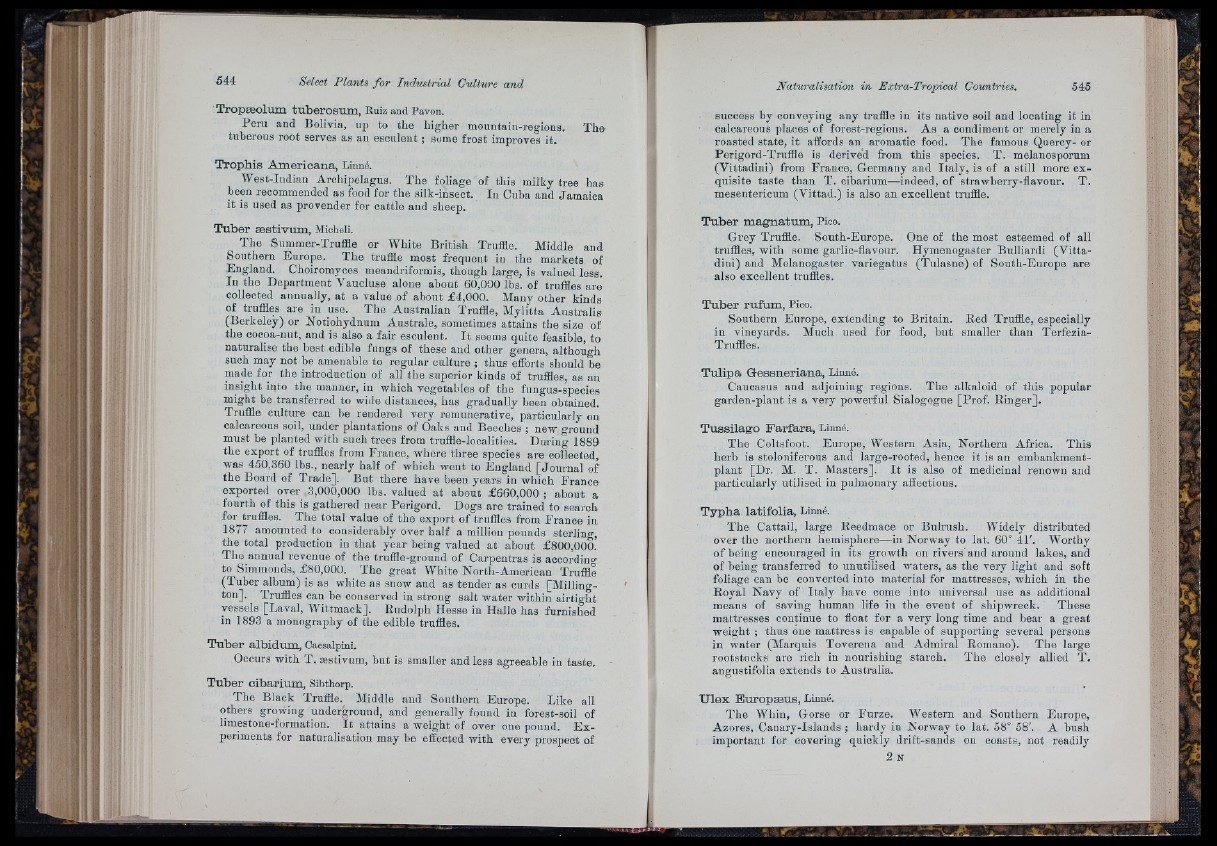
Tropæolum tuberosum, Ruiz and Pavon.
Peru aud Bolivia, up to the higher mountain-regiona. The
tuberous root serves as an esculent ; some frost improves it.
Trophis Americana, Linné.
West-Indian Archipelagus. The foliage of this milky tree has
been recommended as food for the silk-insect. In Cuba and Jamaica
it is used as provender for cattle and sheep.
Tuber æstivum, Mioheli.
The Summer-Truffle or White British Truffle. Middle and
Southern Europe. The truffle most frequent iu the markets of
England. Choiromyces meandriformis, though large, is valued less.
In the Department Vaucluse alone about 60,000 lbs. of truffles are
collected annually, at a value of about £4,000. Many other kinds
of truffles are in use. The Australian Truffle, Mylitta Australis
(Berkeley) or Notiohyduum Australe, sometimes attains the size of
the cocoa-nut, and is also a fair esculent. I t seems quite feasible, to
naturalise the best edible fungs of these aud other genera, although
such may not he amenable to regular culture ; thus efforts should be
made for the introduction of all the superior kinds of truffles, as an
insight into the manner, in which vegetables of the fungus-species
might be transferred to wide distances, has gradually been obtained.
Truffle culture can be rendered very remunerative, particularly on
calcareous soil, under plantations of Oaks and Beeches ; new ground
must he planted with such trees from truffle-localities. During 1889
the export of truffles from France, where three species are collected,
was 450,360 lbs., nearly half of which went to England [Journal of
the Board of Trade]. But there have been years in which France
exported over 3,000,000 lbs. valued a t about £660,000 ; about a
fourth of this is gathered near Perigord. Dogs are trained to search
for truffles. The total value of the export of truffles from France in
1877 amounted to considerably over half a million pounds sterling,
the total production in th a t year being valued at about £800,000.
The annual revenue of the truffle-ground of Carpentras is according
to Simmonds, £80,000. The great White North-American Truffle
(Tuber album) is as white as snow and as tender as curds [Millington].
Truffles can be conserved in strong salt water within airtight
vessels [Laval, Wittmack]. Rudolph Hesse in Halle has furnished
in 1893 a mouography of the edible truffles.
Tuber albidum, Gaesalpini.
Occurs with T. æstivum, hut is smaller and less agreeable in taste.
Tuber cibarium, Sibthorp.
The Black Truffle. Middle and Southern Europe. Like all
others growing underground, and generally found in forest-soil of
limestone-formation. I t attains a weight of over one pound. E x periments
for naturalisation may be effected with every prospect of
success by conveying any truffle in its native soil and locating it in
calcareous places of forest-regions. As a condiment or merely in a
roasted state, it affords an aromatic food. The famous Quercy- or
Perigord-Truffle is derived from this species. T . melanosporum
(Vittadini) from France, Germany aud Italy, is of a still more ex quisite
taste than T. cibarium—indeed, of strawberry-flavour. T.
mesentericum (Vittad.) is also an excellent truffle.
Tuber magnatum, Pioo.
Grey Truffle. South-Europe. One of the most esteemed of all
truffles, with some garlic-flavour. Hymenogaster Bulliardi (Vitta-
dini) and Melanogaster variegatus (Tulasne) of South-Europe are
also excellent truffles.
Tuber rufum, Pico.
Southern Europe, extending to Britain. Red Truffle, especially
in vineyards. Much used for food, but smaller than Terfezia-
Truffles.
Tulipa Gessneriana, Linné.
Caucasus and adjoining regions. The alkaloid of this popular
garden-plant is a very powerful Sialogogue [Prof. Ringer].
Tussilage Farfara, Linné.
The Coltsfoot. Europe, Western Asia, Northern Africa. This
herb is stoloniferous and large-rooted, hence it is an embankment-
plant [Dr. M. T . Masters]. I t is also of medicinal renown and
particularly utilised iu pulmonary affections.
Typha latifolia, Linné.
The Cattail, large Reedmace or Bulrush. Widely distributed
over the northern hemisphere—in Norway to lat. 60° 41'. Worthy
of being encouraged in its growth on rivers and around lakes, and
of being transferred to unutilised waters, as the very light and soft
foliage can be converted into material for mattresses, which iu the
Royal Navy of Ita ly have come into universal use as additional
means of saving human life in the event of shipwreck. These
mattresses continue to float for a very long time and bear a great
weight ; thus one mattress is capable of supporting several persons
in water (Marquis Toverena and Admiral Romano). The large
rootstocks are rich in nourishing starch. The closely allied T.
angustifolia extends to Australia.
U le x Europæus, Linné.
The Whin, Gorse or Furze. Western and Southern Europe,
Azores, Canary-Islands ; hardy in Norway to lat. 58° 58'. A bush
important for covering quickly drift-sands on coasts, not readily